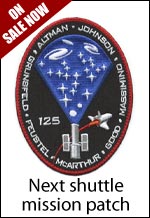


|

|

|
|
Bolt removed from Soyuz, placed in blast-proof case BY WILLIAM HARWOOD STORY WRITTEN FOR CBS NEWS "SPACE PLACE" & USED WITH PERMISSION Posted: July 10, 2008 Space station cosmonauts Sergei Volkov and Oleg Kononenko cut open insulation on their Soyuz re-entry vehicle today, successfully removed an explosive bolt from a suspect connector and locked it in a blast-proof sleeve for return to Earth. The unprecedented space surgery was ordered to help Russian engineers troubleshoot a module separation problem that caused steep, rougher-than-usual descents during the most recent two Soyuz landings. "The MLI (multi-layer insulation) is flying around again," one of the cosmonauts commented as the operation proceeded. "We've ravaged the vehicle," agreed the other, according to an interpreter in Russian mission control. After cutting through the insulation, the cosmonauts struggled to remove a locking wire from the target pyrobolt. Then, using a hex wrench, they finally succeeded in unscrewing the bolt from its housing. "Be careful, be very careful," mission control urged. The pyrobolt had the explosive potential of an M-80 firework, but Russian flight controllers said it would be virtually impossible to accidentally detonate. Even so, the cosmonauts were repeatedly told to take their time and "be very careful." Finally, at 6:44 p.m., with both cosmonauts hunched over the gaping wound in the Soyuz insulation, Volkov successfully disconnected the explosive bolt and slipped it into the cylindrical blast canister. "It is in!" "Good. Thanks, God," one of the spacewalkers said. "It is in." "Disabled the mine," someone quipped. With the explosive bolt safely locked in its canister, the cosmonauts turned their attention to photographing the work site and beginning work to cover up the cut in the protective insulation. A final task, to install a docking target on the Zvezda command module's upper port, was deferred to a more routine spacewalk next week. The Soyuz is made up of three connected sections, but only one of them - the central descent module - is designed to carry a crew back to Earth. Just before atmospheric entry, explosive bolts fire, severing connections holding the modules together. During the two most recent Soyuz entries, the lower propulsion module failed to cleanly separate from the crew cabin, presumably because at least one of the five connectors holding it in place did not release properly. Each connector features two redundant pyrobolts. The bolt removed today was from the same connector suspected of hanging up in the previous two Soyuz entries. As part of the pyrobolt removal procedure, the spacewalkers opened the connector in question, leaving the other four connectors intact. If nothing else, that should help ensure no hang up in that area of the module interface when Volkov, Kononenko and a U.S. space tourist use the Soyuz TMA-12 spacecraft to return to Earth in October.
|
|
|
|
|
||||||||||||||||||||||||||||||||||||||||